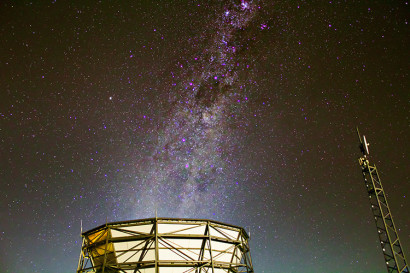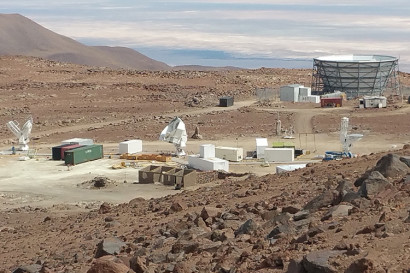Berkeley, California - The Simons Foundation has given $38.4 million to establish a new astronomy facility in Chile’s Atacama Desert, adding new telescopes and new detectors to existing instruments in order to boost ongoing studies of the evolution of the universe, from its earliest moments to today. The Heising-Simons Foundation is providing an additional $1.7 million to support the project.

The plane of the Milky Way Galaxy rising above the ACT telescope, which will merge with the Simons Array to become the Simons Observatory. (Jon Ward photo)
The Simons Observatory is a collaboration among Princeton University, the University of California at San Diego, the University of California, Berkeley, the University of Pennsylvania and Lawrence Berkeley National Laboratory, all of which are also providing financial support.
The observatory will allow scientists to probe the subtle properties of the cosmic microwave background radiation, in particular its polarization, to better understand what took place a fraction of a second after the Big Bang. While these events are hidden from view behind the glare of the microwave radiation, the disturbances they caused in the fabric of spacetime affected the microwave’s polarization, and scientists hope to work backwards from these measurements to test theories about how the universe came into existence.
“A key target of this observatory is the earliest moments in the history of the universe,” said project spokesperson Mark Devlin, a cosmologist at the University of Pennsylvania who is also a 1993 UC Berkeley Ph.D. and the leader of the Penn contingent at the Simons Observatory. “While patterns that we see in the microwave sky are a picture of the structure of the universe 380,000 years after the Big Bang, we believe that some of these patterns were generated much earlier, by gravitational waves produced in the first moments of the universe’s expansion. By measuring how the gravitational waves affect electrons and matter 380,000 years after the big bang, we are observing fossils from the very, very early universe.”
One key goal is to detect gravitational waves generated by cosmic inflation, an extraordinarily rapid expansion of space that, according to the most popular cosmological theory, took place 10-36 seconds after the Big Bang. These primordial gravitational waves induced a very small but characteristic polarization pattern, called B-mode polarization, in the microwave background radiation that can be detected by telescopes and cameras like those planned for the Simons Observatory.

The site of the planned Simons Observatory, located at an elevation of 17,000 feet in Chile’s Atacama Desert, already includes the Simons Array, an expansion of the POLARBEAR experiment (foreground) and the Atacama Cosmology Telescope (background). The Simons Array telescopes have an active diameter of 2.5 meters. The ACT, housed in a large fixed ground screen, incorporates a 6-meter-diameter primary mirror.
“Once we see the signal of inflation, it will be the beginning of a whole new era of cosmology,” said Adrian Lee, a UC Berkeley professor of physics and one of the lead investigators of the observatory. “We will then be looking at a time when the energy density in the universe was a trillion times higher than that of the Large Hadron Collider at CERN, a regime where gravity acts quantum mechanically, string theory may leave its fingerprint and we may learn something about the multiverse.”
In 2012, the collider at the European Center for Nuclear Research (CERN) discovered the long-sought Higgs particle, which gives mass to all matter in the universe. Cosmological observations can probe the universe at much higher energies than the CERN collider, and perhaps answer long-standing questions such as how to unify quantum mechanics and gravity in a theory of quantum gravity, a so-called theory of everything; whether string theory – the idea that all fundamental particles are really one-dimensional strings – really describes the physics of the universe; and whether our universe is just one of many or perhaps an infinity of multiverses.
By measuring how radiation from the early universe changed as it traveled through space to Earth, the observatory also will help astrophysicists learn about the nature of dark energy and dark matter, the properties of neutrinos and how large-scale structure formed as the universe grew.
Primordial gravitational waves
A challenge to detecting the signature of inflation in the cosmic microwave background — CMB — is the need to disentangle it from interfering signals emanating from our own Milky Way galaxy, such as those from dust particles. In the past few years, ground- and space-based experiments have reached an unprecedented level of sensitivity. On-going searches for evidence of inflation have been limited not by sensitivity but by uncertainties in modeling emission from our own galaxy. Based on this realization, “A key feature of the Simons Observatory will be to use spectrum- or color-based discrimination to peer behind the dust in our galaxy and search for a true signal from the Big Bang,” Lee said.

The Huan Tran Telescope, now part of the Simons Array, was the key detector of the POLARBEAR experiment to study the polarization of light from a period 380,000 years after the Big Bang.
Two existing instruments at the site – the Atacama Cosmology Telescope and the Simons Array – are currently measuring this polarization. The foundation funds will merge these two experiments, expand the search and develop new technology for a fourth-stage, next-generation project – dubbed CMB-S4 – that could conceivably mine all the cosmological information in the cosmic microwave background fluctuations possible from the ground.
“We are still in the planning stage for CMB-S4, and this is a wonderful opportunity for the foundations to create a seed for the ultimate experiment,” said Akito Kusaka, a physicist at Lawrence Berkeley National Laboratory and one of the lead investigators. “This gets us off to a quick start.”
The Simons Observatory is designed to be a first step toward the fourth-stage project, an ultimate experiment aimed at extracting the full measure of cosmological information in the cosmic microwave background fluctuations accessible from the ground. CMB-S4 builds on years of support from the National Science Foundation (NSF), and the Department of Energy (DOE) has recently announced its intent to participate in CMB-S4. It is envisioned to have telescopes at multiple sites and draw together a broad community of experts from the U.S. and abroad. The Atacama site in Chile has already been identified as an excellent location for CMB-S4, and the Simons Foundation funding will help develop it for that role.
“We are hopeful that CMB-S4 would shed light not only on inflation, but also on the dark elements of the universe: neutrinos and so-called dark energy and dark matter,” Kusaka said. “The nature of these invisible elements is among the biggest questions in particle physics as well.”
Beyond POLARBEAR
Experiments at the Chilean site have already paved the way for CMB-S4. A 2012 UC Berkeley-led experiment called POLARBEAR used a 3.5-meter telescope at the Chilean site to measure the gravitational-lensing-generated B-mode polarization of the cosmic microwave background radiation, and team scientists confirmed in 2014 that the signal was strong enough to allow them eventually to measure the neutrino mass and the evolution of dark energy.
The recent addition of two more telescopes upgrades POLARBEAR to the Simons Array, which will speed up the mapping of the CMB and improves sky and frequency coverage. The $40 million in new funding will make possible the successor to the Simons Array and the nearby Atacama Cosmology Telescope.
Current stage-3 experiments for these short-wavelength microwaves, which must be chilled to three-tenths of a degree Kelvin above absolute zero, have about 10,000 pixels, Lee said.
“We need to make a leap in our technology to pave the way for the 500,000 detectors required for the ultimate experiment,” he said. “We’ll be generating the blueprint for a much more capable telescope.”
“The generosity of this award is unprecedented in our field, and will enable a major leap in scientific capability,” said astrophysicist Brian Keating, leader of the UC San Diego contingent and current project director. “People are used to thinking about mega- or giga-pixel detectors in optical telescopes, but for signals in the microwave range 10,000 pixels is a lot. What we’re trying to do — the real revolution here — is to pave the way to increase our pixels number by more than an order of magnitude.”
The campus and Berkeley Lab will contribute $1.25 million in matching funds to the project over the next five years. The $1.7 million contributed by the Heising-Simons Foundation will be devoted to supporting research at Berkeley to improve the microwave detectors and to develop fabrication methods that are more efficient and cheaper, with the goal of boosting the number of detectors in CMB experiments by more than a factor of a 10.
The site in Chile is located in the Parque Astronómico, which is administered by the Comisión Nacional de Investigación Científica y Tecnológica (CONICYT). Since 1998, US investigators and the NSF have worked with Chilean scientists, the University of Chile and CONICYT to locate multiple projects at this high, dry site to study the CMB.
